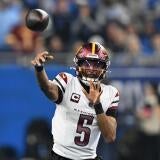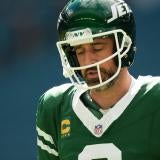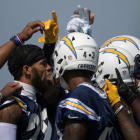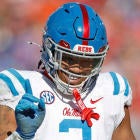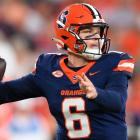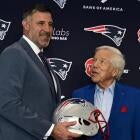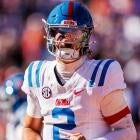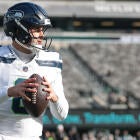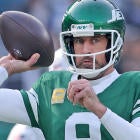COSTA MESA, Calif. -- It's commonplace for coaches and NFL types to talk about the inevitability of injuries in an almost casual, cavalier manner. It's a violent game. Injuries will happen. Next man up.
But for a Chargers franchise fighting for market share in a suddenly crowded Los Angeles NFL landscape in their first season located up the coast from San Diego, and coming off four straight years of devastating injuries, the normal rhetoric wasn't good enough any longer. No team has been more prone to devastating and sweeping injuries -- wiping out the offensive line at times; wide receivers at others; and on and on it goes -- and rarely if ever getting to see a semblance of their starting lineup on the field at once.
It was no small factor in costing former head coach Mike McCoy his job, and prompted another organization-wide sweeping rethink this offseason. No element will be more imperative to the outcome of the Chargers' 2017 season than preventing and staving off injury. If they stem the tide this could truly be the year they jump up in the AFC West after their recent doldrums, and if their depth gets compromised again, then it'll likely be back to the bottom of the division.
The front office conducted exhaustive research, reached out to outside consultants and collected info from other professional sports teams seeking ways to end this rash of health problems, and are keeping their fingers crossed that their luck is about to turn. They'll never be immune to football misfortune -- already this summer they've lost second-round pick Forrest Lamp, who was expected to upgrade an ever-in-flux offensive line, for the season, and they have no firm timetable as to when top pick Mike Williams will be back from a significant back problem that will wipe out his preseason and early part of the regular season, at the least.
But otherwise, so far so good, which is a positive by Chargers' standards, and the hope around here is the worst of the blows are already behind them.
"We all knew that we've got to figure something out," general manager Tom Telesco told me after an injury-free (whew!) practice Tuesday. "We just can't rely on the fact that, oh it's football, and you're going to have injuries, and we've had some bad luck. So we looked at every injury, how it happened when it happened, the situation and circumstances around it. And as far as player personnel and bringing guys in, we've always been on the cautious side in terms of bringing in players, but it might not always seem like that."
The charge to discern ways to curb this trend started at the very top with ownership, and involved all specters of football operations. Were they drafting the wrong, injury-prone players? Did their offseason workout program and OTA structure have anything to do with it? How many of these injuries may have been preventable through different medical or strength and conditioning means?
Everything went under the microscope, from strength and conditioning to the training room, recovery techniques, biomechanics, assessing their facilities and equipment and nutritional programs. They rethought practice scheduled and methods of evaluating injury histories in regards to player acquisition.
The exercise included studying other pro and college football programs, but the team also reached out to MLB's Dodgers and Angels for methods and theories of injury prevention, with Telesco engaging in conversations with forward-thinking baseball execs like Josh Byrnes and Billy Eppler for advice and strategies. They wanted to take a major step back and evaluate everything from the grassroots on up with a holistic approach, with the endeavor no small part of their overall offseason plan, and coming amid a franchise relocation no less.
"This is something I really started taking a look at during the season last year," Telesco said. "You can have layer personnel and coaching going, which is great, but guys have to stay on the field and we have to find ways to do that. You're constantly trying to work to find an edge in what you can do to keep a player on the field."
The Chargers ended up with 21 players on injured reserve a year ago, including a host of key players and vital cogs. That meant a lot of players trying to rehab and recover from injuries this offseason, which puts more stress on everyone. By this time a year ago they already had a growing core of stalwarts on the shelf, and the fact they had another poor season (5-11) certainly had something to do with all the time lost by guys like Keenan Allen, Danny Woodhead, Branden Oliver, Stevie Johnson, Dexter McCluster, Manti Te'o, Brandon Mebane missing much if not all of the season, and Joey Bosa missing part of it.
"Obviously, last year was a pretty crazy year for injuries," said Bosa, who if healthy could lead the NFL in sacks this season and become the face of this franchise. "But I think guys are in really good shape and they're really trying to take care of their bodies … It's very important to the team to stay on the field for 16 games, and you've got to make sure you're taking care of your body every single day. It's unfortunate those two guys (Williams and Lamp) are out, but we're going to keep working and hopefully minimize as many as we can."
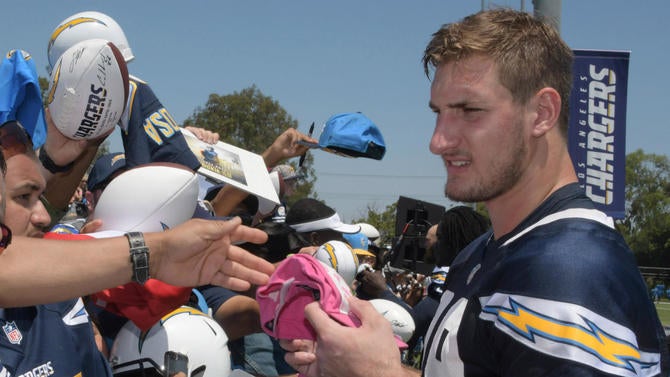
Football Outsiders uses a metric called "Adjusted Games Lost" to try to quantify the quantity and extent of starting time lost to injury, and in recent years the Chargers have consistently ranked in the bottom six, and only the Bears finished worse in the statistic last year. Something that happens on such a regular basis doesn't seem entirely fluky, and it begged more exploration into whether there was something in the DNA here. It's staggering to think in terms of sunk player costs and percentage of salary-cap vanished on players who amassed that many man games lost.
The club overhauled its strength staff, the most tangible sign of change. John Lott, with 19 years of experience, took over as strength and condition coordinator, and they hired Jonathan Brooks from esteemed training company EXOS, which specializes in prepping draft prospects for the combine, as an assistant strength coach and Larry Jackson from Texas A&M, as another assistant.
"We changed up our offseason program and it was different from what they are used to," rookie head coach Anthony Lynn said. "We focused on more basic training at the very beginning of OTAs and more distance running. Working on stamina. Trying to limit fatigue. Because we found out a lot our soft tissue injuries were coming from fatigue. So instead of being just position specific we opened it up to more track-like practices, and I think that will make a big difference.
"The key in the offseason for the strength and conditioning staff was to figure out which guys need what, because you can't just throw one cookie cutter program out there to try to fit everyone. And John Lott I think is one of the best in the game and I think he's done a heck of a job figuring that out."
There was a degree of excitement today as young impact corner Jason Verrett, on his way back from ACL surgery, was more active in practice and making strides. Williams, meantime, was working on a back field individually with trainers and running some, a positive development in its own right (though his absence could be quite prolonged).
If nothing else, perhaps the Chargers will be able to keep their starters aligned in the trenches, where injuries have long mounted; playing center for them in recent years is tantamount to playing drums for Spinal Tap (without the spontaneous combustion, as best I can tell). Rivers has affixed particular attention there, where the signing of veteran left tackle Russell Okung could pay big dividends (he played 16 games for Denver last year and won a Super Bowl in Seattle, but, gulp, has played just one full season since being a first-round pick in 2010 and has missed 24 games in a seven-year career).
"I think that group has a chance to be a really good group if they can keep working together, and if we can keep them all out there together," said the ageless quarterback, who's entering his 14th season. "We had Keenan (on IR) last year and Woodhead (on IR) and we've had all of that, but up here (along the line), when it's a different guy every week, it's hard when you're talking about running the football and communicating protections. So hopefully we're going to keep whatever five, and you're always going to need six, seven and eight (linemen), but if we can keep them out for the most part, it'll really help us."
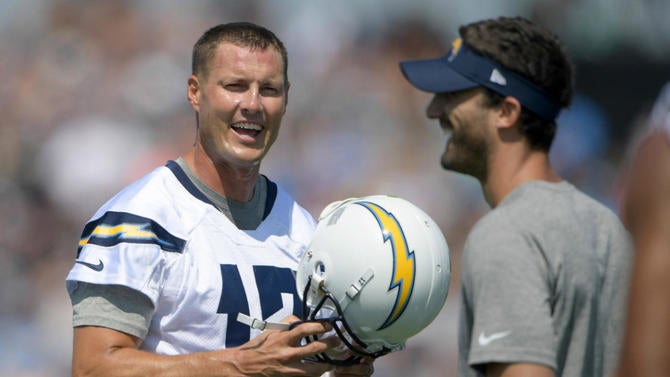
Of course, for Rivers, it's a familiar refrain. He's always fired up this time of year and feels refreshed and renewed. He looks at the roster and seems ample potential and a nice mix of old and young. Then by mid-August they're down a few linchpins, and by Week 4 the team has usually lost another handful of starters. Perhaps all of the hours spent assessing why that's been the case will pay off in 2017, and, one imagines, the football gods have to eventually shine on the Chargers and their new staff.
"I've been very close with every strength coach we've ever had here in the past," Rivers said. "And I've always felt like we were doing the right thing. So to say that now we've finally figured it out, I don't think so, man, I don't know. You just throw your hands up and say, 'What are you going to do?'
"And I think every time there has been a change they've tried to do all they can to help us and I feel like we're strong and so far we haven't had anything except for losing Forrest Lamp, and we haven't had our first-round pick yet, so those two are really the only place we've been hit real hard so far. So I think they've done all they can and some of it, maybe it will finally fall our way this time."
![[object Object] Logo](https://sportshub.cbsistatic.com/i/2020/04/22/e9ceb731-8b3f-4c60-98fe-090ab66a2997/screen-shot-2020-04-22-at-11-04-56-am.png)



